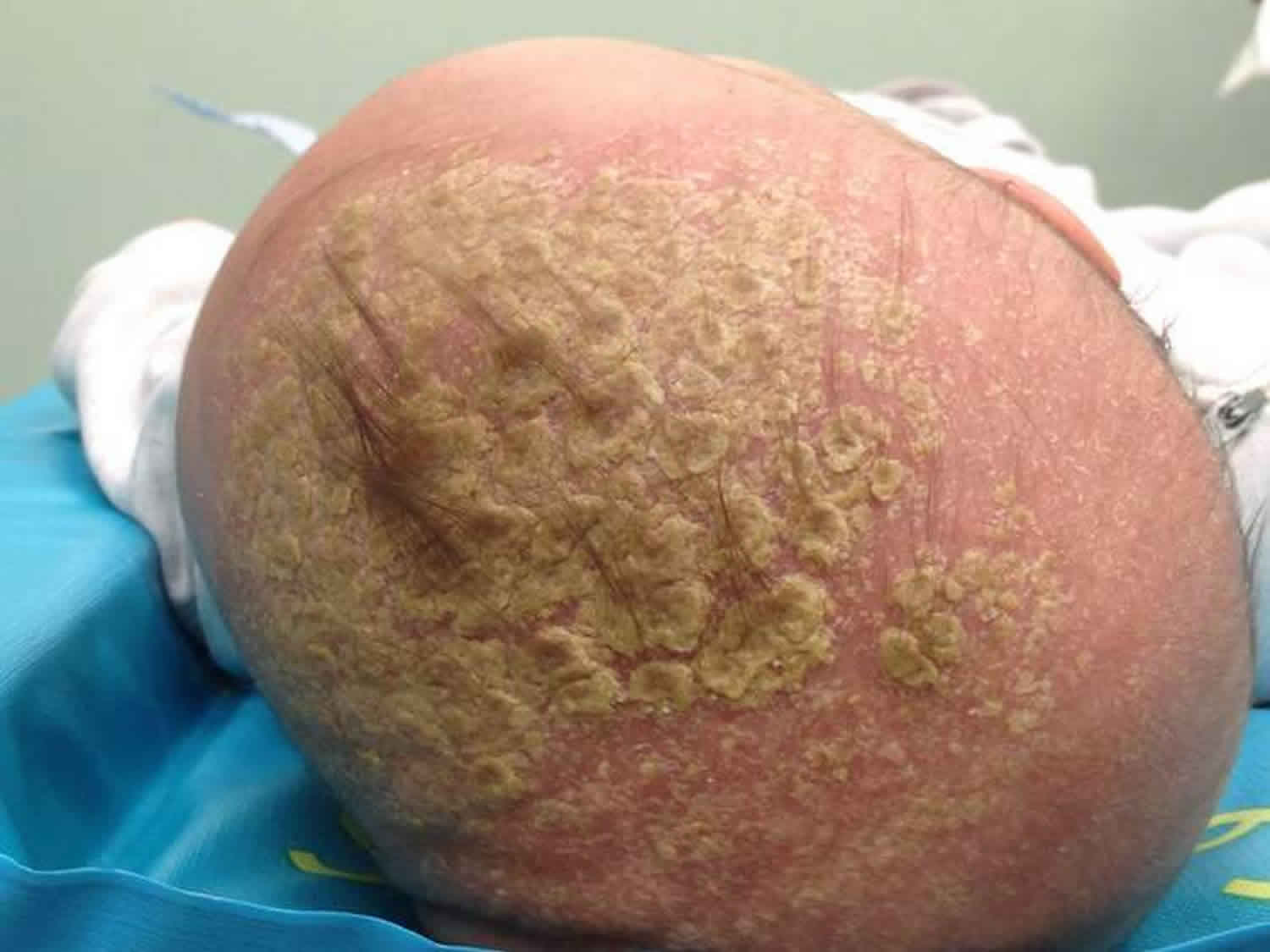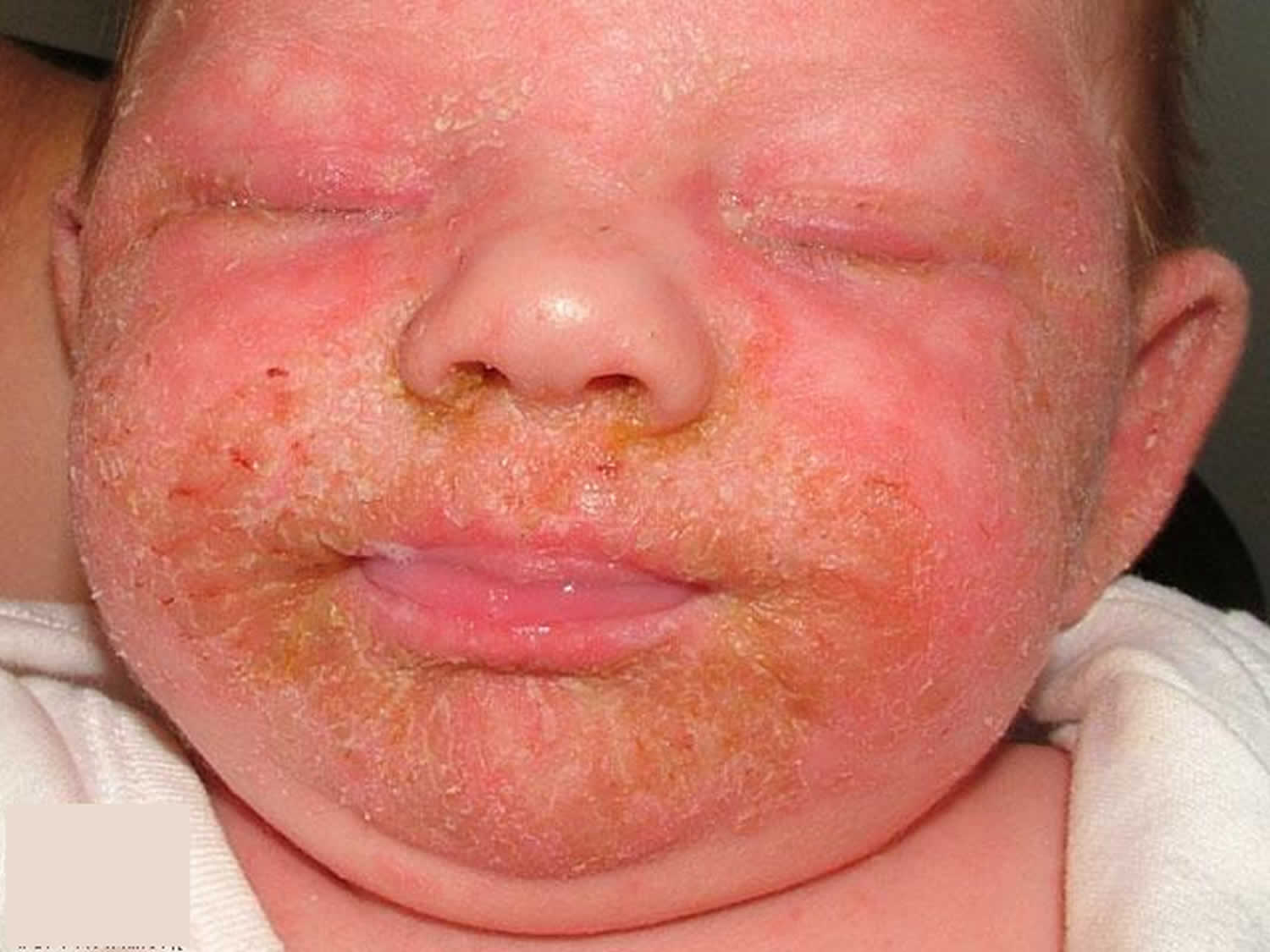Infantile seborrheic dermatitis
Infantile seborrheic dermatitis also called cradle cap or napkin dermatitis, is a common form of eczema or dermatitis that mainly affects the oil producing gland (sebaceous gland) rich regions of the scalp, face or trunk of infants within the first few months postpartum. Sometimes seborrheic dermatitis appears on the infant’s face, especially around the eyes and nose area. It can also appear in the diaper area and in the folds of babies’ skin. Infantile seborrhoeic dermatitis affects babies under the age of 3 months and usually resolves by 6–12 months of age. In some children, the condition can last until age 2 or 3. In older children and adults, seborrheic dermatitis on the scalp is typically called dandruff.
Infantile seborrheic dermatitis appears to be an inflammatory response to malassezia yeasts, which proliferate in oily skin (seborrhea). In infants it is supposed that maternal androgens are responsible.
Infantile seborrheic dermatitis is not spread from person to person (contagious). It is also not caused by poor hygiene. It is not an allergy, and it is not dangerous.
Characteristically, the scale is yellowish and greasy or white and bran-like associated with variable nummular or annular pale pink to bright red patches. Itching tends to be absent or mild.
For the most part, babies are unbothered by the symptoms of seborrheic dermatitis. For more severe cases, it is important to be on the lookout for any signs of infection such as skin that feels hot, weeps fluid or smells bad. Contact your child’s doctor if you suspect your child has an infection.
If the infantile seborrheic dermatitis is mild, an over-the-counter (OT)C topical antifungal cream or medicated shampoo with ketoconazole, selenium sulfide, coal tar or zinc pyrithione, may be enough to control symptoms. Be sure the shampoo doesn’t get in your baby’s eyes, as it may cause irritation. It is okay to leave mild seborrheic dermatitis untreated if your child is not uncomfortable. Don’t use over-the-counter cortisone or antifungal creams without talking to your baby’s doctor, because some of these products can be toxic when absorbed through a baby’s skin. Dandruff shampoos that contain salicylic acid aren’t recommended for use in babies either, because they can be absorbed through the skin.
In more severe cases, your baby’s doctor may prescribe topical steroids or topical calcineurin inhibitors (e.g., Pimecrolimus cream) to calm the inflammation. Oral antifungal agents may also be used.
Figure 1. Infantile seborrheic dermatitis on face
Footnote: A severe case of seborrheic dermatitis in an infant. Note the yellowish crust and scale.
See your child’s doctor if:
- Scales on your baby’s scalp or other skin symptoms do not go away or get worse after home care
- Patches drain fluid or pus, form crusts, or become very red or painful
- Your baby develops a fever (may be due to infection getting worse).
Infantile seborrheic dermatitis cause
The exact cause of infantile seborrheic dermatitis is not known. Doctors think the condition is due to oil glands in the baby’s scalp producing too much oil. Scientists believed infantile seborrheic dermatitis is caused by a combination of factors including genes, yeast that lives naturally on the skin, stress, chemical irritants and/or dry, cold weather that causes the skin to overproduce oil. In infants, researchers believe seborrheic dermatitis is triggered in part by hormones from the mother.
Infantile seborrheic dermatitis has been thought as a result of proliferation of fungus of Malassezia species (e.g., Malassezia furfur, Malassezia ovalis) and Pityrosporum ovale 1. Extensive and generalizedinfantile seborrheic dermatitis is very uncommon in healthy infant and its presence should make the health care personal to investigate for immunodeficiency in infant like HIV 2.
Infantile seborrheic dermatitis symptoms
Infantile seborrheic dermatitis causes cradle cap (diffuse, greasy scaling on scalp). However, each child may experience symptoms differently. The rash may spread to affect armpit and groin folds (a type of napkin dermatitis).
- There are salmon-pink patches that may flake or peel.
- Scales may also be found on the eyelids, ear, around the nose.
- It is not especially itchy, so the baby often appears undisturbed by the rash, even when generalized.
- Older infant scratching affected areas, which may lead to infection (redness, bleeding, or crusting).
Infantile seborrheic dermatitis diagnosis
In most cases the diagnosis of infantile seborrheic dermatitis is made clinically on physical examination of your child. The rash involved with cradle cap is unique, and can usually be diagnosed simply on physical examination.
Infantile seborrheic dermatitis treatment
Management of cradle cap may consist of gently washing with a baby shampoo after a proprietary oil or lotion has been used to soften the scales (e.g. Egocappol, Egozite lotion). More troublesome seborrheic dermatitis affecting the scalp can be managed as in an adult:
- Shampoo twice weekly (or if desired, daily if there are scales) with antidandruff shampoo containing:
- Keratolytics such as salicylic acid and sulphur
- Antifungal agents especially ketoconazole and ciclopirox (also miconazole, selenium sulphide and zinc pyrithione)
- Coal tar or pine tar
- Brush your child’s hair with a clean, soft brush after each shampoo and several times during the day. Wash the brush with soap and water each day to remove any scales and scalp oil.
- If scales do not easily loosen and wash off, apply mineral oil to the baby’s scalp and wrap warm, wet cloths around the head for up to an hour before shampooing. Then, shampoo. Remember that your baby loses heat through the scalp. If you use warm, wet cloths with the mineral oil, check often to be sure that the cloths have not become cold. Cold, wet cloths can reduce your baby’s temperature.
- Leave-on tar preparation e.g. coconut oil compound ointment, washed off after an hour or so.
- Intermittent use of mild potency topical steroid lotion.
Management of seborrheic dermatitis affecting non-hair bearing areas:
- Minimal use of emollients (malassezia is lipophilic)
- Cleanse with non-soap cleanser or anti-dandruff shampoo
- Keratolytic cleansers or creams containing salicylic acid and/or sulphur
- Topical antifungal cream especially ketoconazole or ciclopirox
- Intermittent use of mild topical steroid or tar preparations
If the scales continue to be a problem or your child seems uncomfortable or scratches the scalp all the time, see your child’s doctor.
References





